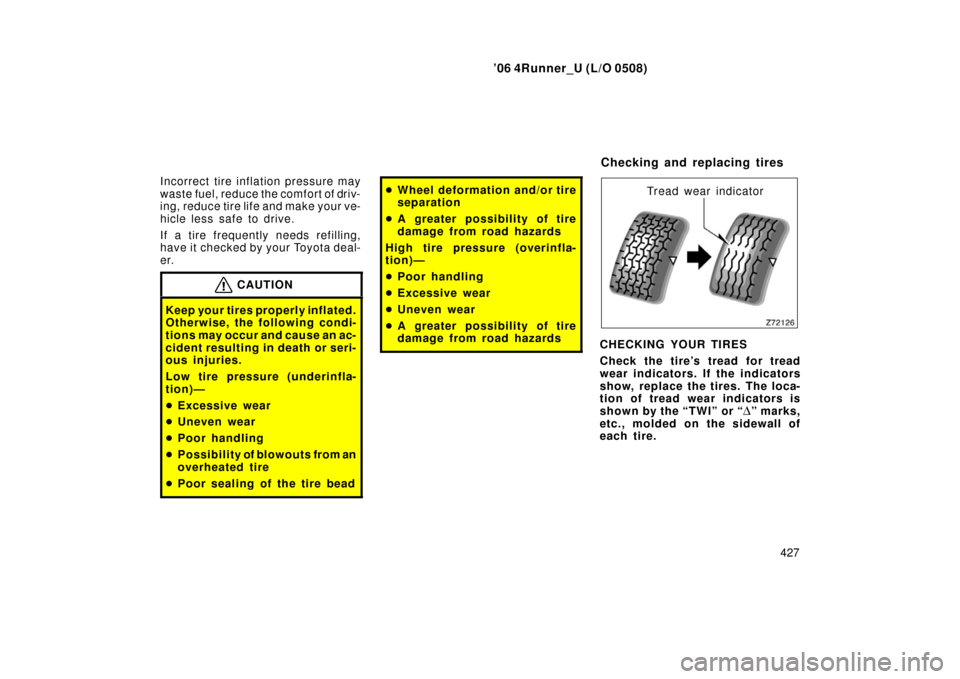Page 409 of 470

’06 4Runner_U (L/O 0508)
399
Check the interior of your vehicle. Wa-
ter and dirt can accumulate under the
floor mats and could cause corrosion. Oc-
casionally check under the mats to make
sure the area is dry. Be particularly care-
ful when transporting chemicals, cleans-
ers, fertilizers, salt, etc; these should be
transported in proper containers. If a spill
or leak should occur, immediately clean
and dry the area.
Use mud shields on your wheels. If you
drive on salted or gravel roads, mud
shields help protect your vehicle. Full −size
shields, which come as near to the ground
as possible, are the best. We recommend
that the fittings and the area where the
shields are installed be treated to resist
corrosion. Your Toyota dealer will be
happy to assist in supplying and installing
the shields if they are recommended for
your area.
Keep your vehicle in a well ventilated
garage or a roofed place. Do not park
your vehicle in a damp, poorly venti-
lated garage. If you wash your vehicle in
the garage, or if you drive it covered with
water or snow, your garage may be so
damp as to cause corrosion. Even if your
garage is heated, a wet vehicle can cor-
rode if the ventilation is poor. Washing your Toyota
Keep your vehicle clean by regular
washing.
The following cases may cause weakness
to the paint or corrosion to the body and
parts. Wash your vehicle as soon as pos-
sible.
�When driving in a coastal area
�When driving on a road sprinkled with
antifreeze
�When exposed to coal tar, tree sap,
bird droppings and carcass of an insect
�When driving in areas where there is
a lot of smoke, soot, dust, iron dust or
chemical substances
�When the vehicle becomes remarkably
dirty with dust and mud
Hand�washing your Toyota
Work in the shade and wait until the
vehicle body is not warm to the touch.
CAUTION
When cleaning under floor or chassis,
be careful not to injure your hands.
1. Rinse off loose dirt with a hose. Re- move any mud or road salt from the
underside of the vehicle or the wheel
wells.
2. Wash with a mild car −wash soap,
mixed according to the manufacturer ’s
instructions. Use a soft cotton mitt and
keep it wet by dipping it frequently into
the wash water. Do not rub hard—let
the soap and water remove the dirt.
Fuel filler door: Do not apply water (high −
pressure car wash, for example) at or
near the fuel tank inlet with the fuel filler
door opened. If the water enters the air
vent, you may experience trouble with re-
fueling or rough engine idling.
Rear height control air suspension: Do not
spray a jet of high −pressure water at the
air suspension unit, especially the air
spring, at an extremely close range. This
may damage the air suspension.
Plastic wheel ornaments: The plastic
wheel ornaments are damaged easily by
organic substances. If any organic sub-
stances splash an ornament, be sure to
wash them off with water and check if the
ornament is damaged.
Washing and waxing your
To y o t a
Page 437 of 470

’06 4Runner_U (L/O 0508)
427
Incorrect tire infl
ation pressure may
waste fuel, reduce the comfort of driv-
ing, reduce tire life and make your ve-
hicle less safe to drive.
If a tire frequently needs refilling,
have it checked by your Toyota deal-
er.
CAUTION
Keep your tires properly inflated.
Otherwise, the following condi-
tions may occur and cause an ac-
cident resulting in death or seri-
ous injuries.
Low tire pressure ( underinfla-
tion)—
� Excessive wear
� Uneven wear
� Poor handling
� Possibility of blowouts from an
overheated tire
� Poor sealing of the tire bead
�Wheel deformation and/or tire
separation
� A greater possibility of tire
damage from road hazards
High tire pressure (overinfla-
tion)—
� Poor handling
� Excessive wear
� Uneven wear
� A greater possibility of tire
damage from road hazardsTread wear indicator
CHECKING YOUR TIRES
Check the tire’s tread for tread
wear indicators. If the indicators
show, replace the tires. The loca-
tion of tread wear indicators is
shown by the “TWI” or “
Δ” marks,
etc., molded on the sidewall of
each tire.
Checking and replacing tires
Page 463 of 470

’06 4Runner_U (L/O 0508)
453
19. ECU�B 10 A: Anti−lock brake system,
traction control system (two −wheel
drive models), active traction control
system (four −wheel drive models), ve-
hicle stability control system, air condi-
tioning system, multiplex communica-
tion system, theft deterrent system,
driving position memory system, front
passenger occupant classification sys-
tem
20. ALT�S 7.5 A: Charging system
21. HORN 10 A: Horns
22. A/F HEATER 15 A: A/F sensor
23. TRN�HAZ 15 A: Turn signal lights,
emergency flashers
24. ETCS 10 A: Multiport fuel injection
system/s equential multiport fuel injec-
tion system
25. EFI 20 A: Multiport fuel injection sys-
tem/sequential multiport fuel injection
system
26. DR/LCK 20 A: Power door lock system
27. TOWING 30 A: Towing converter
28. RADIO NO.2 20 A: Audio system29. IGN 10 A:
Multiport fuel injection sys-
tem/sequential multiport fuel injection
system, anti −lock brake system, trac-
tion control system (two −wheel drive
models), active traction control system
(four− wheel drive models), vehicle sta-
bility control system, meter and gauge,
front passenger occupant classification
system
30. SRS 10 A: SRS airbag system
31. GAUGE 7.5 A: Meter and gauge
32. STA NO.2 7.5 A: Multiport fuel injec-
tion system/sequential multiport fuel in-
jection system
33. FR WIP�WSH 30 A: Windshield wipers
and washer
34. 4WD 20 A: Four−wheel drive control
system
35. D P/SEAT 30 A: Driver ’s power seat
36. P P/SEAT 30 A: Front passenger ’s
power seat
37. PWR OUTLET 15 A: Power outlets
38. RR WSH 15 A: Back window washer,
multiplex communication system 39. ECU�IG 10 A:
Shift lock control sys-
tem, power windows, anti −lock brake
system, traction control system (two −
wheel drive models), active traction
control system (four −wheel drive mod-
els), vehicle stability control system,
electric moon roof, multiplex commu-
nication system, theft deterrent system,
rear height control air suspension, tire
pressure warning system, driving posi-
tion memory system
40. IG1 15 A: Anti−lock brake system,
traction control system (two −wheel
drive models), active traction control
syste
m (four −wheel drive models), ve-
hicle stability control system, air condi-
tioning system, charging system, back
window defogger, back −up lights, emer-
gency flashers, seat heaters, AC invert-
er, instrument panel light control, auto
anti −glare inside rear view mirror, seat
belt tension reducer
41. STA 7.5 A: No circuit
42. SECU/HORN 10 A: Theft deterrent sys-
tem
Page 467 of 470

’06 4Runner_U (L/O 0508)
I
Publication No. OM35852U
Part No. 01999-35852
Printed in Japan 01−0508 −00
4
Quick index
� If a service reminder indicator or warning buzzer comes on 147 . . . . . . . .
� If your vehicle will not start 374 . . . . . . . . . . . . . . . . . . . . . . . . . . . . . . . . . . . . .\
. .
� If your engine stalls while driving 377 . . . . . . . . . . . . . . . . . . . . . . . . . . . . . . . . . .
� If your vehicle overheats 378 . . . . . . . . . . . . . . . . . . . . . . . . . . . . . . . . . . . . .\
. . . . .
� If you have a flat tire 379 . . . . . . . . . . . . . . . . . . . . . . . . . . . . . . . . . . . . .\
. . . . . . . .
� If your vehicle needs to be towed 389 . . . . . . . . . . . . . . . . . . . . . . . . . . . . . . . . .
� Tips for driving during break −in period 329 . . . . . . . . . . . . . . . . . . . . . . . . . . . . .
� How to start the engine 356 . . . . . . . . . . . . . . . . . . . . . . . . . . . . . . . . . . . . .\
. . . . . .
� General maintenance 407 . . . . . . . . . . . . . . . . . . . . . . . . . . . . . . . . . . . . .\
. . . . . . . . .
Gas station information
Fuel type:
UNLEADED gasoline, Octane Rating 87 (Research Octane Number 91) or
higher.
For improved vehicle performance, use premium unleaded gasoline with an
Octane Rating of 91 (Research Octane Number 96) or higher.
See page 329 for detailed information.
Fuel tank capacity:
87 L (23.0 gal., 19.1 Imp. gal.)
Engine oil:
ILSAC multigrade engine oil is recommended.
See page 421 for detailed information.
Tire information: See pages 425 through 432.
Tire inflation pressure: See page 451.
U�1